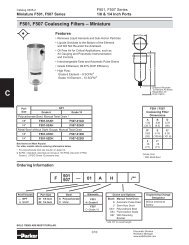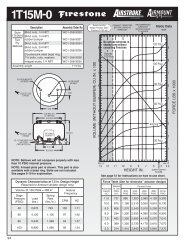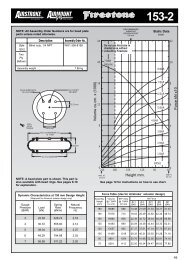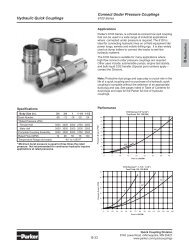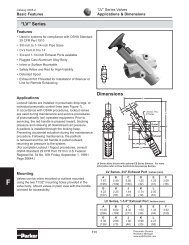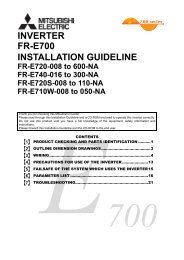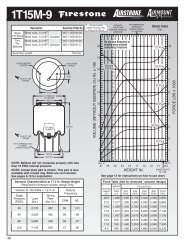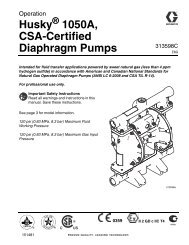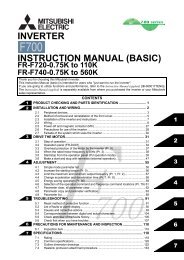Parker Industrial Hose Catalog 4800 - MRO Stop
Parker Industrial Hose Catalog 4800 - MRO Stop
Parker Industrial Hose Catalog 4800 - MRO Stop
You also want an ePaper? Increase the reach of your titles
YUMPU automatically turns print PDFs into web optimized ePapers that Google loves.
HOSESafety & Technical Datapremature <strong>Hose</strong> failure. Any <strong>Hose</strong> that has been kinked orbent to a radius smaller than the minimum bend radius, andany <strong>Hose</strong> that has been cut or is cracked or is otherwise damaged,should be removed and discarded.2.12 Proper End Fitting: See instructions 3.2 through3.5. These recommendations may be substantiated bytesting to industry standards such as SAE J517 for hydraulicapplications, or MIL-A-5070, AS1339, or AS3517 for <strong>Hose</strong>sfrom <strong>Parker</strong>’s Stratoflex Products Division for aerospaceapplications.2.13 Length: When establishing a proper <strong>Hose</strong> length,motion absorption, <strong>Hose</strong> length changes due to pressure,and <strong>Hose</strong> and machine tolerances and movement must beconsidered.2.14 Specifications and Standards: When selecting <strong>Hose</strong>and Fittings, government, industry, and <strong>Parker</strong> specificationsand recommendations must be reviewed and followed asapplicable.2.15 <strong>Hose</strong> Cleanliness: <strong>Hose</strong> components may vary incleanliness levels. Care must be taken to insure that the<strong>Hose</strong> Assembly selected has an adequate level of cleanlinessfor the application.2.16 Fire Resistant Fluids: Some fire resistant fluids thatare to be conveyed by <strong>Hose</strong> require use of the same type of<strong>Hose</strong> as used with petroleum base fluids. Some such fluidsrequire a special <strong>Hose</strong>, while a few fluids will not work withany <strong>Hose</strong> at all. See instructions 2.5 and 1.5. The wrong<strong>Hose</strong> may fail after a very short service. In addition, all liquidsbut pure water may burn fiercely under certain conditions, andeven pure water leakage may be hazardous.2.17 Radiant Heat: <strong>Hose</strong> can be heated to destructionwithout contact by such nearby items as hot manifolds ormolten metal. The same heat source may then initiate a fire.This can occur despite the presence of cool air around the<strong>Hose</strong>.2.18 Welding or Brazing: When using a torch or arcwelderin close proximity to hydraulic lines, the hydraulic linesshould be removed or shielded with appropriate fire resistantmaterials. Flame or weld spatter could burn through the <strong>Hose</strong>and possibly ignite escaping fluid resulting in a catastrophicfailure. Heating of plated parts, including <strong>Hose</strong> Fittings andadapters, above 450°F (232°C) such as during welding, brazing,or soldering may emit deadly gases.2.19 Atomic Radiation: Atomic radiation affects all materialsused in <strong>Hose</strong> assemblies. Since the long-term effectsmay be unknown, do not expose <strong>Hose</strong> assemblies to atomicradiation.2.20 Aerospace Applications: The only <strong>Hose</strong> and Fittingsthat may be used for in flight aerospace applications are thoseavailable from <strong>Parker</strong>’s Stratoflex Products Division. Do notuse any other <strong>Hose</strong> or Fittings for in flight applications. Donot use any <strong>Hose</strong> or Fittings from <strong>Parker</strong>’s Stratoflex ProductsDivision with any other <strong>Hose</strong> or Fittings, unless expresslyapproved in writing by the engineering manager or chief engineerof Stratoflex Products Division and verified by the user’sown testing and inspection to aerospace industry standards.2.21 Unlocking Couplings: Ball locking couplings or othercouplings with disconnect sleeves can unintentionally disconnectif they are dragged over obstructions or if the sleeve isbumped or moved enough to cause disconnect. Threadedcouplings should be considered where there is a potential foraccidental uncoupling.3.0 HOSE AND FITTING ASSEMBLY ANDINSTALLATION INSTRUCTIONS3.1 Component Inspection: Prior to assembly,a careful examination of the <strong>Hose</strong> and Fittings must beperformed. All components must be checked for correct style,Purchase at http://www.mrostop.comsize, catalog number, and length. The <strong>Hose</strong> must be examinedfor cleanliness, obstructions, blisters, cover looseness,kinks, cracks, cuts or any other visible defects. Inspect theFitting and sealing surfaces for burrs, nicks, corrosion or otherimperfections. Do NOT use any component that displays anysigns of nonconformance.3.2 <strong>Hose</strong> and Fitting Assembly: Do not assemble a<strong>Parker</strong> Fitting on a <strong>Parker</strong> <strong>Hose</strong> that is not specifically listedby <strong>Parker</strong> for that Fitting, unless authorized in writing by theengineering manager or chief engineer of the appropriate<strong>Parker</strong> division. Do not assemble a <strong>Parker</strong> Fitting on anothermanufacturers <strong>Hose</strong> or a <strong>Parker</strong> <strong>Hose</strong> on another manufacturersFitting unless (i) the engineering manager or chief engineerof the appropriate <strong>Parker</strong> division approves the Assemblyin writing or that combination is expressly approved in theappropriate <strong>Parker</strong> literature for the specific <strong>Parker</strong> product,and (ii) the user verifies the Assembly and the applicationthrough analysis and testing. For <strong>Parker</strong> <strong>Hose</strong> that does notspecify a <strong>Parker</strong> Fitting, the user is solely responsible for theselection of the proper Fitting and <strong>Hose</strong> Assembly procedures.See instruction 1.4.The <strong>Parker</strong> published instructions must be followed forassembling the Fittings on the <strong>Hose</strong>. These instructions areprovided in the <strong>Parker</strong> Fitting catalog for the specific <strong>Parker</strong>Fitting being used, or by calling 1-800-CPARKER, or atwww.parker.com.3.3 Related Accessories: Do not crimp or swage any<strong>Parker</strong> <strong>Hose</strong> or Fitting with anything but the listed swage orcrimp machine and dies in accordance with <strong>Parker</strong> publishedinstructions. Do not crimp or swage another manufacturersFitting with a <strong>Parker</strong> crimp or swage die unless authorized inwriting by the engineering manager of chief engineer of theappropriate <strong>Parker</strong> division.3.4 Parts: Do not use any <strong>Parker</strong> Fitting part (including butnot limited to socket, shell, nipple, or insert) except with thecorrect <strong>Parker</strong> mating parts, in accordance with <strong>Parker</strong> publishedinstructions, unless authorized in writing by the engineeringmanager or chief engineer of the appropriate <strong>Parker</strong>division.3.5 Reusable/Permanent: Do not reuse any field attachable(reusable) <strong>Hose</strong> Fitting that has blown or pulled offa <strong>Hose</strong>. Do not reuse a <strong>Parker</strong> permanent <strong>Hose</strong> Fitting(crimped or swaged) or any part thereof. Complete <strong>Hose</strong>Assemblies may only be reused after proper inspection undersection 4.0. Do not assemble Fittings to any previously usedhydraulic <strong>Hose</strong> that was in service, for use in a fluid powerapplication.3.6 Pre-Installation Inspection: Prior to installation,a careful examination of the <strong>Hose</strong> Assembly must beperformed. Inspect the <strong>Hose</strong> Assembly for any damage ordefects. Do NOT use any <strong>Hose</strong> Assembly that displays anysigns of nonconformance.3.7 Minimum Bend Radius: Installation of a <strong>Hose</strong> at lessthan the minimum listed bend radius may significantly reducethe <strong>Hose</strong> life. Particular attention must be given to precludesharp bending at the <strong>Hose</strong> to Fitting juncture. Any bendingduring installation at less than the minimum bend radius mustbe avoided. If any <strong>Hose</strong> is kinked during installation, the <strong>Hose</strong>must be discarded.3.8 Twist Angle and Orientation: <strong>Hose</strong> Assembly installationmust be such that relative motion of machine componentsdoes not produce twisting.3.9 Securement: In many applications, it may benecessary to restrain, protect, or guide the <strong>Hose</strong> to protect itfrom damage by unnecessary flexing, pressure surges, andcontact with other mechanical components. Care must betaken to insure such restraints do not introduce additionalstress or wear points.198<strong>Parker</strong> Hannifin Corporation<strong>Industrial</strong> <strong>Hose</strong> Productswww.safehose.com



